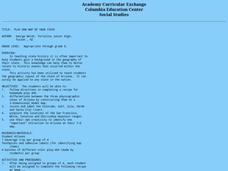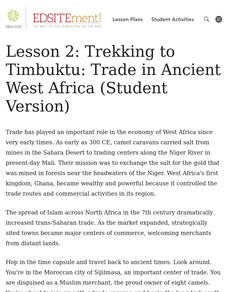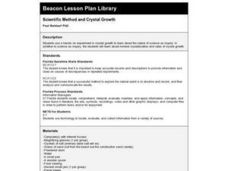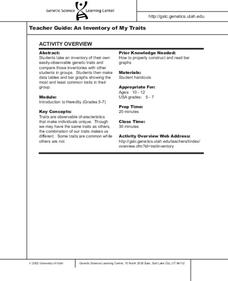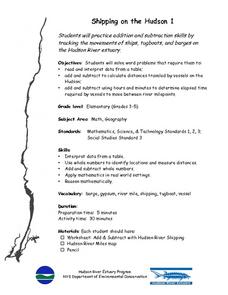Curated OER
Isn't It Ionic?
Students research the properties and health risks of organic chemical solvents. They create a Safety with Solvents newsletter to share with others in their school and community.
Curated OER
Taste
Young scholars collect data to be used in selecting the class favorite taste. They predict which among the common flavors such as salty, sweet, sour, or bitter is preferred.
Curated OER
Play Doh Map of Your State
Students create a state map using Playdoh. In this hands-on state geography lesson, students work in groups to form a three-dimensional map of their state using Playdoh made at home following a (given) recipe. Students use four colors...
Curated OER
Trekking to Timbuktu: Trade in Ancient West Africa
Students research how trade in Timbuktu was affected by geography. Students conduct online research to determine the major trade routes, main products of trade, plus how and why trade spread across Africa.
Curated OER
The Weight of Water
Young scholars examine how salt water is more dense than fresh water through experimentation with eggs.
Curated OER
Scientific Method and Crystal Growth
Students conduct a hands-on experiment growing crystals to demonstrate the nature of science as inquiry. They discuss and test variables that affect crystal growth. They research mineral crystallization and mineral formation on the...
Curated OER
What's the Matter? (Grades 6-7)
Learners explain the physical properties of matter. They, in groups, perform a variety of experiments, each demonstrating a different property of matter. A very nice, hands-on lesson!
Curated OER
Chemical Sleuthing
Students engage in a lesson which includes flame tests and the construction of a simple diffraction spectrograph with which to measure sodium ion emissions. They use the Bragg equation to compute the wavelength of the line spectra produced.
Curated OER
DNA Extraction From Onion
Students extract DNA from an onion using household equipment and supplies.
Curated OER
Capillary Action and Adhesion
Students perform classroom experiments to observe adhesion. They perform a second experiment using sand, salt, water, and a heat lamp to observe the principle of capillary action. They also experiment with adhesion in plants.
Curated OER
Ocean Life
Students explore the topics of ocean water salinity, ocean life zones, marine life classification, and ocean food chains. They observe demonstrations, conduct experiments, complete quizzes and handouts, and analyze key vocabulary.
Curated OER
Animal Report
Fourth graders explore the variety of resources available to them at the library. They utilize many of these resources to create an animal report with a set criterium.
Curated OER
Animal Report
Fourth graders research an animal of their choice and take the information in outline form, and write paragraphs to complete a final report form, draw a picture of their subject, and mount for display.
Curated OER
Presidents
Fifth graders choose a particular president to research. They define the task of the project, brainstorm questions, list and evaluate possible sources to answer their questions.
Curated OER
Presidents
Fifth graders explore the encyclopedia and take notes from it in a formatted way. They analyze and compare the encyclopedia to an almanac and begin to take information on their chosen president.
Curated OER
An Inventory of My Traits
Students take an inventory of their own easily-observable genetic traits and
compare those inventories with other students in groups. They then make
data tables and bar graphs showing the most and least common traits in their group.
Curated OER
Columns
Young scholars view a video clip on skyscrapers. They discover how columns support different size loads. They participate in activities and discuss their results.
Curated OER
Osmosis Investigation
Students investigate osmosis as they determine how carrot cells respond to two different environments. They conduct the experiment, record the data, and answer discussion questions.
Curated OER
Molecular Movement in Water Part 1- Diffusion
Young scholars obseve and compare molecular movement within water at various temperatures and of varying salinity. They discuss the movement of water on a larger scale which can affect the movement and concentrations of microbial...
Curated OER
Family Life Cycle - Older Adult Lab
Students pretend to be old by simulating some of the struggles older people face every day with arthritis in their hands, hearing impaired, and normal loss of up close vision as they experience preparing a recipe. They identify the...
Curated OER
Measuring the Effect of Adrenaline on the Heart Rate of Zebra Fish
Students investigate the heart beat of zebra fish in timed intervals. They record the heart beats and average three counts to display in their data tables. They repeat these steps increasing the adrenaline solution.
Curated OER
Water Density and Salinity
Students observe how different water densities control the depth at which different water masses occur. They explain one fact that they comprehend about salt water. Students comprehend that temperature and salinity affect the density...
Curated OER
Shipping on the Hudson
Students track movements of ships, tugboats, and barges on the Hudson River estuary in order to practice addition and subtraction skills. They solve word problems by reading and interpreting data from a table. They calculate distances...
Curated OER
Adaptations of Fishes for Survival in Polar Environments
Students compare the anatomy of temperature and polar fishes. They explore the adverse effects of cold on metabolism and physiology and discuss how polar fishes adapt to their environments. Comparisons are also made to the DNA sequences...
Other popular searches
- Salt Dough Map
- Salt Water
- Salt Marshes
- Salty Oceans
- Gold and Salt Trade
- Great Salt Lake
- Epsom Salt
- Salt Water Chemistry
- Fresh Water Salt Water
- Mahatma Gandhi Salt March
- Growing Salt Crystals
- Freshwater and Saltwater




